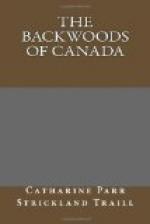But I must now tell you of our sugar-making, in which I take rather an active part. Our experiment was on a very limited scale, having but one kettle, besides two iron tripods; but it was sufficient to initiate us in the art and mystery of boiling the sap into molasses, and finally the molasses down to sugar.
The first thing to be done in tapping the maples, is to provide little rough troughs to catch the sap as it flows: these are merely pieces of pine-tree, hollowed with the axe. The tapping the tree is done by cutting a gash in the bark, or boring a hole with an auger. The former plan, as being most readily performed, is that most usually practised. A slightly-hollowed piece of cedar or elder is then inserted, so as to slant downwards and direct the sap into the trough; I have even seen a flat chip made the conductor. Ours were managed according to rule, you may be sure. The sap runs most freely after a frosty night, followed by a bright warm day; it should be collected during the day in a barrel or large trough, capable of holding all that can be boiled down the same evening; it should not stand more than twenty-four hours, as it is apt to ferment, and will not grain well unless fresh.
My husband, with an Irish lad, began collecting the sap the last week in March. A pole was fixed across two forked stakes, strong enough to bear the weight of the big kettle. Their employment during the day was emptying the troughs and chopping wood to supply the fires. In the evening they lit the fires and began boiling down the sap.
It was a pretty and picturesque sight to see the sugar-boilers, with their bright log-fire among the trees, now stirring up the blazing pile, now throwing in the liquid and stirring it down with a big ladle. When the fire grew fierce, it boiled and foamed up in the kettle, and they had to throw in fresh sap to keep it from running over.
When the sap begins to thicken into molasses, it is then brought to the sugar-boiler to be finished. The process is simple; it only requires attention in skimming and keeping the mass from boiling over, till it has arrived at the sugaring point, which is ascertained by dropping a little into cold water. When it is near the proper consistency, the kettle or pot becomes full of yellow froth, that dimples and rises in large bubbles from beneath. These throw out puffs of steam, and when the molasses is in this stage, it is nearly converted into sugar. Those who pay great attention to keeping the liquid free from scum, and understand the precise sugaring point, will produce an article little if at all inferior to muscovado*.
[* Good well-made maple-sugar bears a strong resemblance to that called powdered sugar-candy, sold by all grocers as a delicate article to sweeten coffee; it is more like maple-sugar in its regular crystallizations.]
In general you see the maple-sugar in large cakes, like bees’ wax, close and compact, without showing the crystallization; but it looks more beautiful when the grain is coarse and sparkling, and the sugar is broken in rough masses like sugar-candy.




